Chronology and Sedimentary Processes in the Western Ross Sea, Antarctica since the Last Glacial Period
Abstract
:1. Introduction
2. Regional Settings
3. Materials and Methods
3.1. Sediment Cores
3.2. Methods
3.2.1. AMS 14C Dating
3.2.2. Grain Size
3.2.3. Magnetic Measurements
4. Results
4.1. Grain-Size Properties
4.2. Radiocarbon Dates
4.3. Tuning Magnetic Susceptibility
4.4. Influences on Magnetic Susceptibility
5. Discussion
5.1. Difference in Age Models
5.2. Paleoenvironmental Processes in the Ross Sea
6. Conclusions
- (1)
- There are two grain-size components identified for the studied cores. The coarse component includes F1 (134.0–466.5 μm) of the core ANT31-JB03, F3 (121.8–213.2 μm) of the core ANT31-JB06, and F1 (116.6–535.9 μm) of the core ANT32-RB16C, which can serve as proxies of IRD. The fine component contains F3 (3.2–4.8 μm) of the core ANT31-JB03, F1 (5.1–17.2 μm) of the core ANT31-JB06, and F2 (2.1–8.4 μm) of the core ANT32-RB16C, which are associated with sea-ice transport.
- (2)
- Based on the high consistency between the magnetic susceptibility of the studied cores and the EDML ice-core nssCa2+ record, the age model can be established. Relatively, the radiocarbon dates are generally underestimated due to old-carbon contamination and an inconsistent carbon reservoir.
- (3)
- Integrating sediment grain-size changes and comparisons with other paleoenvironmental proxies in the Antarctic, the regional processes in the Ross Sea are reconstructed as a sub-ice sheet in the last glacial period, then to a sub-ice shelf in the glacial maximum, and, finally, to a glaciomarine state since the last deglacial period.
Author Contributions
Funding
Institutional Review Board Statement
Informed Consent Statement
Data Availability Statement
Acknowledgments
Conflicts of Interest
References
- Westerhold, T.; Marwan, N.; Drury, A.J.; Liebrand, D.; Agnini, C.; Anagnostou, E.; Barnet, J.S.; Bohaty, S.M.; De Vleeschouwer, D.; Florindo, F. An astronomically dated record of Earth’s climate and its predictability over the last 66 million years. Science 2020, 369, 1383–1387. [Google Scholar] [CrossRef]
- Morgan, V.; Delmotte, M.; van Ommen, T.; Jouzel, J.; Chappellaz, J.; Woon, S.; Masson-Delmotte, V.; Raynaud, D. Relative timing of deglacial climate events in Antarctica and Greenland. Science 2002, 297, 1862–1864. [Google Scholar] [CrossRef]
- Miller, K.G.; Browning, J.V.; Schmelz, W.J.; Kopp, R.E.; Mountain, G.S.; Wright, J.D. Cenozoic sea-level and cryospheric evolution from deep-sea geochemical and continental margin records. Sci. Adv. 2020, 6, eaaz1346. [Google Scholar] [CrossRef]
- Yi, L.; Medina-Elizalde, M.; Tan, L.; Kemp, D.B.; Li, Y.; Kletetschka, G.; Xie, Q.; Yao, H.; He, H.; Deng, C.; et al. Plio-Pleistocene deep-sea ventilation in the Eastern Pacific and potential linkages with Northern Hemisphere glaciation. Sci. Adv. 2023, 9, eadd1467. [Google Scholar] [CrossRef] [PubMed]
- Convey, P.; Peck, L.S. Antarctic environmental change and biological responses. Sci. Adv. 2019, 5, eaaz0888. [Google Scholar] [CrossRef] [PubMed]
- Consortium*†, C.C.P.I.P.; Hönisch, B.; Royer, D.L.; Breecker, D.O.; Polissar, P.J.; Bowen, G.J.; Henehan, M.J.; Cui, Y.; Steinthorsdottir, M.; McElwain, J.C. Toward a Cenozoic history of atmospheric CO2. Science 2023, 382, eadi5177. [Google Scholar] [CrossRef]
- Anderson, H.J.; Pedro, J.B.; Bostock, H.C.; Chase, Z.; Noble, T.L. Compiled Southern Ocean sea surface temperatures correlate with Antarctic Isotope Maxima. Quat. Sci. Rev. 2021, 255, 106821. [Google Scholar] [CrossRef]
- Crosta, X.; Kohfeld, K.E.; Bostock, H.C.; Chadwick, M.; Du Vivier, A.; Esper, O.; Etourneau, J.; Jones, J.; Leventer, A.; Müller, J.; et al. Antarctic sea ice over the past 130,000 years—Part 1: A review of what proxy records tell us. Clim. Past 2022, 18, 1729–1756. [Google Scholar] [CrossRef]
- Weber, M.E.; Golledge, N.R.; Fogwill, C.J.; Turney, C.S.M.; Thomas, Z.A. Decadal-scale onset and termination of Antarctic ice-mass loss during the last deglaciation. Nat. Commun. 2021, 12, 6683. [Google Scholar] [CrossRef]
- Tesi, T.; Belt, S.; Gariboldi, K.; Muschitiello, F.; Smik, L.; Finocchiaro, F.; Giglio, F.; Colizza, E.; Gazzurra, G.; Giordano, P. Resolving sea ice dynamics in the north-western Ross Sea during the last 2.6 ka: From seasonal to millennial timescales. Quat. Sci. Rev. 2020, 237, 106299. [Google Scholar] [CrossRef]
- Silvano, A.; Foppert, A.; Rintoul, S.R.; Holland, P.R.; Tamura, T.; Kimura, N.; Castagno, P.; Falco, P.; Budillon, G.; Haumann, F.A. Recent recovery of Antarctic Bottom Water formation in the Ross Sea driven by climate anomalies. Nat. Geosci. 2020, 13, 780–786. [Google Scholar] [CrossRef]
- Robinson, D.E.; Menzies, J.; Wellner, J.S.; Clark, R.W. Subglacial sediment deformation in the Ross Sea, Antarctica. Quat. Sci. Adv. 2021, 4, 100029. [Google Scholar] [CrossRef]
- Ha, S.; Colizza, E.; Torricella, F.; Langone, L.; Giglio, F.; Kuhn, G.; Macrì, P.; Khim, B.-K. Glaciomarine sediment deposition on the continental slope and rise of the central Ross Sea since the Last Glacial Maximum. Mar. Geol. 2022, 445, 106752. [Google Scholar] [CrossRef]
- Ha, S.; Lee, J.I.; Bak, Y.-S.; Yoo, K.-C.; Khim, B.-K. Paleoenvironmental reconstruction of glaciomarine sediments in the Drygalski Basin of the western Ross Sea since the Last Glacial Maximum. Sediment. Geol. 2023, 456, 106495. [Google Scholar] [CrossRef]
- Greenwood, S.L.; Gyllencreutz, R.; Jakobsson, M.; Anderson, J.B. Ice-flow switching and East/West Antarctic Ice Sheet roles in glaciation of the western Ross Sea. GSA Bull. 2012, 124, 1736–1749. [Google Scholar] [CrossRef]
- Kim, S.; De Santis, L.; Hong, J.K.; Cottlerle, D.; Petronio, L.; Colizza, E.; Kim, Y.-G.; Kang, S.-G.; Kim, H.J.; Kim, S.; et al. Seismic stratigraphy of the Central Basin in northwestern Ross Sea slope and rise, Antarctica: Clues to the late Cenozoic ice-sheet dynamics and bottom-current activity. Mar. Geol. 2018, 395, 363–379. [Google Scholar] [CrossRef]
- King, M.V.; Gales, J.A.; Laberg, J.S.; McKay, R.M.; De Santis, L.; Kulhanek, D.K.; Hosegood, P.J.; Morris, A. Pleistocene depositional environments and links to cryosphere-ocean interactions on the eastern Ross Sea continental slope, Antarctica (IODP Hole U1525A). Mar. Geol. 2022, 443, 106674. [Google Scholar] [CrossRef]
- Li, G.; Bu, R.; Yi, L.; Hu, B.; Li, Y.; Ji, Y.; Li, Y.; Wang, L. Geochronology and Paleoenvironmental Changes of Late Pleistocene Sediments in the Ross Sea, Antarctica. Front. Earth Sci. 2022, 10, 863336. [Google Scholar] [CrossRef]
- Li, G.; Li, Y.; Bu, R.; Ji, Y.; Li, Y.; Zhao, X.; Li, C.; Duan, L. Geochemical characteristics and paleoenvironmental implications of major elements in sediments from the continental slope of the Ross Sea, Antarctica since late Pleistocene. Mar. Geol. Quat. Geol. 2022, 42, 1–11. [Google Scholar] [CrossRef]
- Rosenblume, J.A.; Powell, R.D. Glacial sequence stratigraphy of ANDRILL-1B core reveals a dynamic subpolar Antarctic Ice Sheet in Ross Sea during the late Miocene. Sedimentology 2019, 66, 2072–2097. [Google Scholar] [CrossRef]
- Jin, J.; Chen, X.; Xu, L.; Nie, Y.; Wang, X.; Huang, H.; Emslie, S.D.; Liu, X. Chronology and paleoclimatic implications of lacustrine sediments at Inexpressible Island, Ross Sea, Antarctica. Palaeogeogr. Palaeoclimatol. Palaeoecol. 2021, 576, 110497. [Google Scholar] [CrossRef]
- Bart, P.J.; DeCesare, M.; Rosenheim, B.E.; Majewski, W.; McGlannan, A. A centuries-long delay between a paleo-ice-shelf collapse and grounding-line retreat in the Whales Deep Basin, eastern Ross Sea, Antarctica. Sci. Rep. 2018, 8, 12392. [Google Scholar] [CrossRef] [PubMed]
- Torricella, F.; Melis, R.; Malinverno, E.; Fontolan, G.; Bussi, M.; Capotondi, L.; Del Carlo, P.; Di Roberto, A.; Geniram, A.; Kuhn, G.; et al. Environmental and Oceanographic Conditions at the Continental Margin of the Central Basin, Northwestern Ross Sea (Antarctica) Since the Last Glacial Maximum. Geosciences 2021, 11, 155. [Google Scholar] [CrossRef]
- Yi, L.; Chen, S.; Ortiz, J.D.; Chen, G.; Peng, J.; Liu, F.; Chen, Y.; Deng, C. 1500-year cycle dominated Holocene dynamics of the Yellow River delta, China. Holocene 2016, 26, 222–234. [Google Scholar] [CrossRef]
- Liu, G.; Han, X.; Chen, Y.; Li, J.; Song, L.; Zhou, X.; Hu, B.; Yi, L. Early-Holocene Paleo-Tropical Cyclone Activity Inferred from a Sedimentary Sequence in South Yellow Sea, East Asia. J. Earth. Sci. 2022, 33, 789–801. [Google Scholar] [CrossRef]
- Zhao, R.; Chen, Z.; Liu, H.; Tang, Z.; Huang, Y.; Li, Y.; Ge, S. Sediment record and paleoceanographic implications of the core on the continental shelf off the Ross Sea since 15 ka. Acta Oceanol. Sin. 2017, 39, 78–88. [Google Scholar] [CrossRef]
- Andrews, J.T.; Cunningham, W.L.; DeMaster, D.J.; Domack, E.W.; Jennings, A.E.; Jull, A.J.T.; Leventer, A.; Licht, K.J. Problems and Possible Solutions Concerning Radiocarbon Dating of Surface Marine Sediments, Ross Sea, Antarctica. Quat. Res. 1999, 52, 206–216. [Google Scholar] [CrossRef]
- Cunningham, W.L.; Leventer, A.; Andrews, J.T.; Jennings, A.E.; Licht, K.J. Late Pleistocene-Holocene marine conditions in the Ross Sea, Antarctica: Evidence from the diatom record. Holocene 1999, 9, 129–139. [Google Scholar] [CrossRef]
- Domack, E.W.; Jacobson, E.A.; Shipp, S.; Anderson, J.B. Late Pleistocene–Holocene retreat of the West Antarctic Ice-Sheet system in the Ross Sea: Part 2—Sedimentologic and stratigraphic signature. GSA Bull. 1999, 111, 1517–1536. [Google Scholar] [CrossRef]
- Licht, K.J.; Cunningham, W.L.; Andrews, J.T.; Domack, E.W.; Jennings, A.E. Establishing chronologies from acid-insoluble organic 14C dates on Antarctic (Ross Sea) and Arctic (North Atlantic) marine sediments. Polar Res. 1998, 17, 203–216. [Google Scholar] [CrossRef]
- Xiao, W.; Frederichs, T.; Gersonde, R.; Kuhn, G.; Esper, O.; Zhang, X. Constraining the dating of late Quaternary marine sediment records from the Scotia Sea (Southern Ocean). Quat. Geochronol. 2016, 31, 97–118. [Google Scholar] [CrossRef]
- Pugh, R.S.; McCave, I.N.; Hillenbrand, C.D.; Kuhn, G. Circum-Antarctic age modelling of Quaternary marine cores under the Antarctic Circumpolar Current: Ice-core dust–magnetic correlation. Earth Planet. Sci. Lett. 2009, 284, 113–123. [Google Scholar] [CrossRef]
- Yokoyama, Y.; Anderson, J.B.; Yamane, M.; Simkins, L.M.; Miyairi, Y.; Yamazaki, T.; Koizumi, M.; Suga, H.; Kusahara, K.; Prothro, L.; et al. Widespread collapse of the Ross Ice Shelf during the late Holocene. Proc. Natl. Acad. Sci. USA 2016, 113, 2354–2359. [Google Scholar] [CrossRef] [PubMed]
- Weber, M.E.; Kuhn, G.; Sprenk, D.; Rolf, C.; Ohlwein, C.; Ricken, W. Dust transport from Patagonia to Antarctica—A new stratigraphic approach from the Scotia Sea and its implications for the last glacial cycle. Quat. Sci. Rev. 2012, 36, 177–188. [Google Scholar] [CrossRef]
- Smith, W.O.J.; Sedwick, P.N.; Arrigo, K.R.; Ainley, D.G.; Orsi, A.H. The Ross Sea in a sea of change. Oceanography 2012, 25, 90–103. [Google Scholar] [CrossRef]
- Hang, M.; Wang, R.; Xiao, W.; Wu, L.; Chen, Z. Retreat process of Ross Ice Shelf and hydrodynamic changes on Northwestern Ross continental shelf since the Last Glacial. Mar. Geol. Quat. Geol. 2016, 36, 97–108. [Google Scholar] [CrossRef]
- Anderson, J.B.; Conway, H.; Bart, P.J.; Witus, A.E.; Greenwood, S.L.; McKay, R.M.; Hall, B.L.; Ackert, R.P.; Licht, K.; Jakobsson, M.; et al. Ross Sea paleo-ice sheet drainage and deglacial history during and since the LGM. Quat. Sci. Rev. 2014, 100, 31–54. [Google Scholar] [CrossRef]
- Lee, J.I.; McKay, R.M.; Golledge, N.R.; Yoon, H.I.; Yoo, K.-C.; Kim, H.J.; Hong, J.K. Widespread persistence of expanded East Antarctic glaciers in the southwest Ross Sea during the last deglaciation. Geology 2017, 45, 403–406. [Google Scholar] [CrossRef]
- Cui, C.; Tang, Z.; Rebesco, M.; Santis, L.D. Sedimentary records of enhanced deep ventilation during the last deglaciation in the Ross Sea, Southern Ocean. Quat. Sci. 2021, 41, 678–690. [Google Scholar] [CrossRef]
- Shao, H.; He, J.; Wu, L.; Wei, L. Elemental and Sr–Nd isotopic compositions of surface clay-size sediments in the front end of major ice shelves around Antarctica and indications for provenance. Deep Sea Res. Part II Top. Stud. Oceanogr. 2022, 195, 105011. [Google Scholar] [CrossRef]
- Reimer, P.J.; Austin, W.E.N.; Bard, E.; Bayliss, A.; Blackwell, P.G.; Bronk Ramsey, C.; Butzin, M.; Cheng, H.; Edwards, R.L.; Friedrich, M.; et al. The IntCal20 Northern Hemisphere Radiocarbon Age Calibration Curve (0–55 cal kBP). Radiocarbon 2020, 62, 725–757. [Google Scholar] [CrossRef]
- Yi, L.; Hu, B.; Zhao, J.; Jiang, X.; Shu, Y.; Wang, X.; Guo, J.; Wang, F.; Ding, X.; Liu, G.; et al. Magnetostratigraphy of Abyssal Deposits in the Central Philippine Sea and Regional Sedimentary Dynamics during the Quaternary. Paleoceanogr. Paleoclimatology 2022, 37, e2021PA004365. [Google Scholar] [CrossRef]
- Chen, Y.; Li, Y.; Lyu, W.; Xu, D.; Han, X.; Fu, T.; Yi, L. A 5000-Year Sedimentary Record of East Asian Winter Monsoon from the Northern Muddy Area of the East China Sea. Atmosphere 2020, 11, 1376. [Google Scholar] [CrossRef]
- Chen, Y.; Lyu, W.; Fu, T.; Li, Y.; Yi, L. Centennial Impacts of the East Asian Summer Monsoon on Holocene Deltaic Evolution of the Huanghe River, China. Appl. Sci. 2021, 11, 2799. [Google Scholar] [CrossRef]
- Li, Y.; Chen, Y.; Jiang, X.; Yi, L. Color Reflectance of Coastal Sediments in the South Bohai Sea and its Implication to Orbital Forcing of East Asian Summer Monsoon. Front. Earth Sci. 2021, 9, 760216. [Google Scholar] [CrossRef]
- Passega, R. Grain size representation by CM patterns as a geologic tool. J. Sediment. Res. 1964, 34, 830–847. [Google Scholar] [CrossRef]
- Weltje, G.J.; Prins, M.A. Genetically meaningful decomposition of grain-size distributions. Sediment. Geol. 2007, 202, 409–424. [Google Scholar] [CrossRef]
- Sun, D.; Bloemendal, J.; Rea, D.K.; Vandenberghe, J.; Jiang, F.; An, Z.; Su, R. Grain-size distribution function of polymodal sediments in hydraulic and aeolian environments, and numerical partitioning of the sedimentary components. Sediment. Geol. 2002, 152, 263–277. [Google Scholar] [CrossRef]
- Lei, G.; Zhang, H.; Zhang, W.; Niu, J.; Yang, M.; Chen, Y.; Fan, H.; Chang, F.; Li, B. The reliability and significance of the grainsize obtained by Mastersize 2000 laser analyzer. Acta Sedimentol. Sin. 2006, 24, 531–539. [Google Scholar] [CrossRef]
- Blaauw, M.; Christen, J.A. Flexible paleoclimate age-depth models using an autoregressive gamma process. Bayesian Anal. 2011, 6, 457–474. [Google Scholar] [CrossRef]
- Heaton, T.J.; Köhler, P.; Butzin, M.; Bard, E.; Reimer, R.W.; Austin, W.E.N.; Bronk Ramsey, C.; Grootes, P.M.; Hughen, K.A.; Kromer, B.; et al. Marine20—The Marine Radiocarbon Age Calibration Curve (0–55,000 cal BP). Radiocarbon 2020, 62, 779–820. [Google Scholar] [CrossRef]
- Stuiver, M.; Reimer, P.J. Extended 14C Data Base and Revised CALIB 3.0 14C Age Calibration Program. Radiocarbon 1993, 35, 215–230. [Google Scholar] [CrossRef]
- Fischer, H.; Fundel, F.; Ruth, U.; Twarloh, B.; Wegner, A.; Udisti, R.; Becagli, S.; Castellano, E.; Morganti, A.; Severi, M.; et al. Reconstruction of millennial changes in dust emission, transport and regional sea ice coverage using the deep EPICA ice cores from the Atlantic and Indian Ocean sector of Antarctica. Earth Planet. Sci. Lett. 2007, 260, 340–354. [Google Scholar] [CrossRef]
- Kotov, S.; Paelike, H. QAnalySeries—A cross-platform time series tuning and analysis tool. ESS Open Archive, 18 December 2018. [Google Scholar]
- Lisiecki, L.E.; Raymo, M.E. A Pliocene-Pleistocene stack of 57 globally distributed benthic δ18O records. Paleoceanography 2005, 20, PA1003. [Google Scholar] [CrossRef]
- Roberts, A.P.; Tauxe, L.; Heslop, D.; Zhao, X.; Jiang, Z. A Critical Appraisal of the “Day” Diagram. J. Geophys. Res. Solid Earth 2018, 123, 2618–2644. [Google Scholar] [CrossRef]
- Zheng, Y.; Anderson, R.F.; Beck, W.; Froelich, P.N.; Guilderson, T.; McNichol, A.P. Challenges in Radiocarbon Dating Organic Carbon in Opal-Rich Marine Sediments. Radiocarbon 2002, 44, 123–136. [Google Scholar] [CrossRef]
- Buizert, C.; Adrian, B.; Ahn, J.; Albert, M.; Alley, R.B.; Baggenstos, D.; Bauska, T.K.; Bay, R.C.; Bencivengo, B.B.; Bentley, C.R.; et al. Precise interpolar phasing of abrupt climate change during the last ice age. Nature 2015, 520, 661–665. [Google Scholar] [CrossRef]
- Barbante, C.; Barnola, J.M.; Becagli, S.; Beer, J.; Bigler, M.; Boutron, C.; Blunier, T.; Castellano, E.; Cattani, O.; Chappellaz, J.; et al. One-to-one coupling of glacial climate variability in Greenland and Antarctica. Nature 2006, 444, 195–198. [Google Scholar] [CrossRef]
- Etourneau, J.; Sgubin, G.; Crosta, X.; Swingedouw, D.; Willmott, V.; Barbara, L.; Houssais, M.-N.; Schouten, S.; Damsté, J.S.S.; Goosse, H.; et al. Ocean temperature impact on ice shelf extent in the eastern Antarctic Peninsula. Nat. Commun. 2019, 10, 304. [Google Scholar] [CrossRef]
- Denton, G.H.; Marchant, D.R. The geologic basis for a reconstruction of a grounded ice sheet in McMurdo Sound, Antarctica, at the Last Glacial Maximum. Geogr. Ann. Ser. A Phys. Geogr. 2000, 82, 167–211. [Google Scholar] [CrossRef]
- Hall, B.L.; Baroni, C.; Denton, G.H. Holocene relative sea-level history of the southern Victoria Land coast, Antarctica. Glob. Planet. Chang. 2004, 42, 241–263. [Google Scholar] [CrossRef]
- Jones, R.S.; Mackintosh, A.N.; Norton, K.P.; Golledge, N.R.; Fogwill, C.J.; Kubik, P.W.; Christl, M.; Greenwood, S.L. Rapid Holocene thinning of an East Antarctic outlet glacier driven by marine ice sheet instability. Nat. Commun. 2015, 6, 8910. [Google Scholar] [CrossRef] [PubMed]
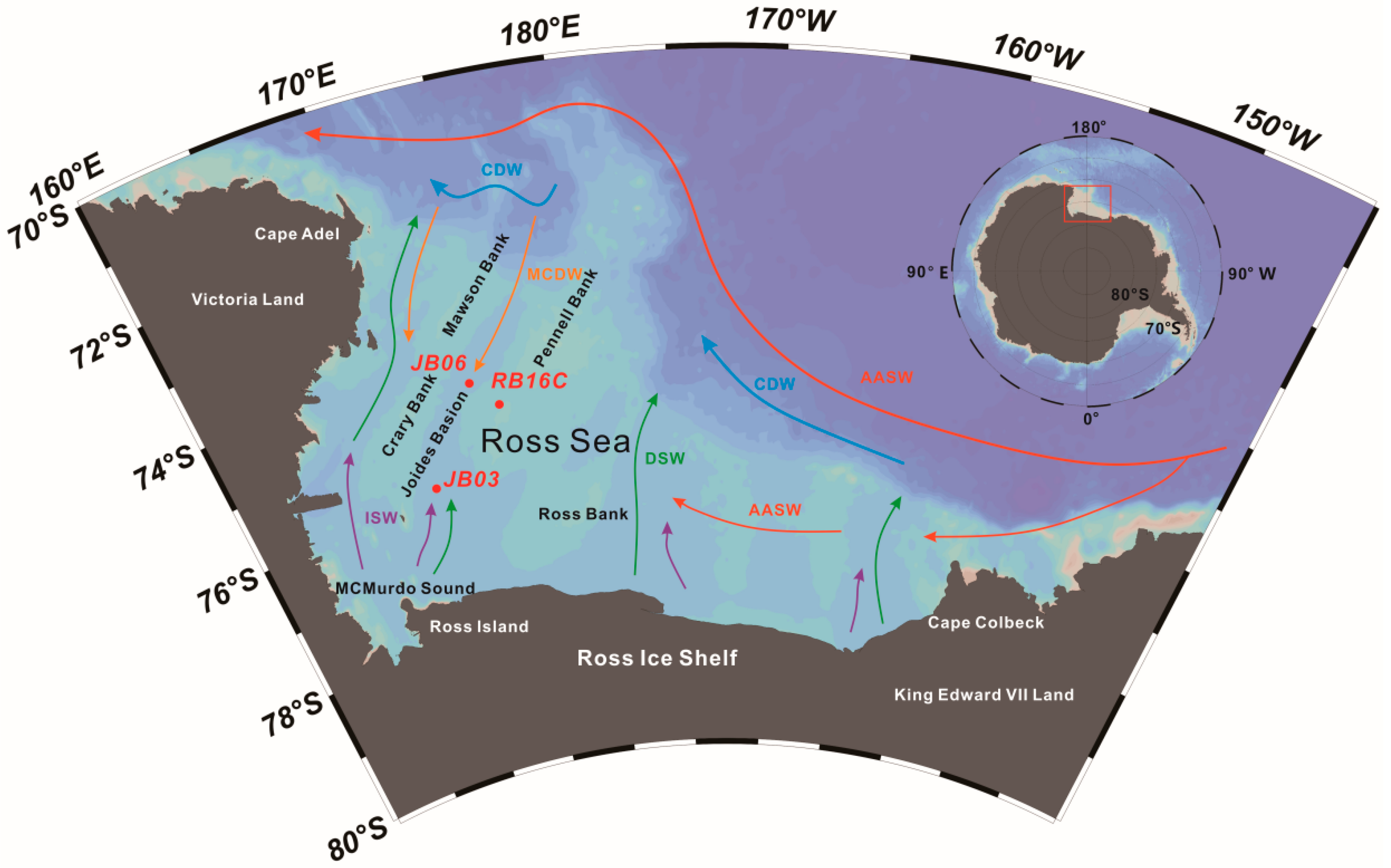

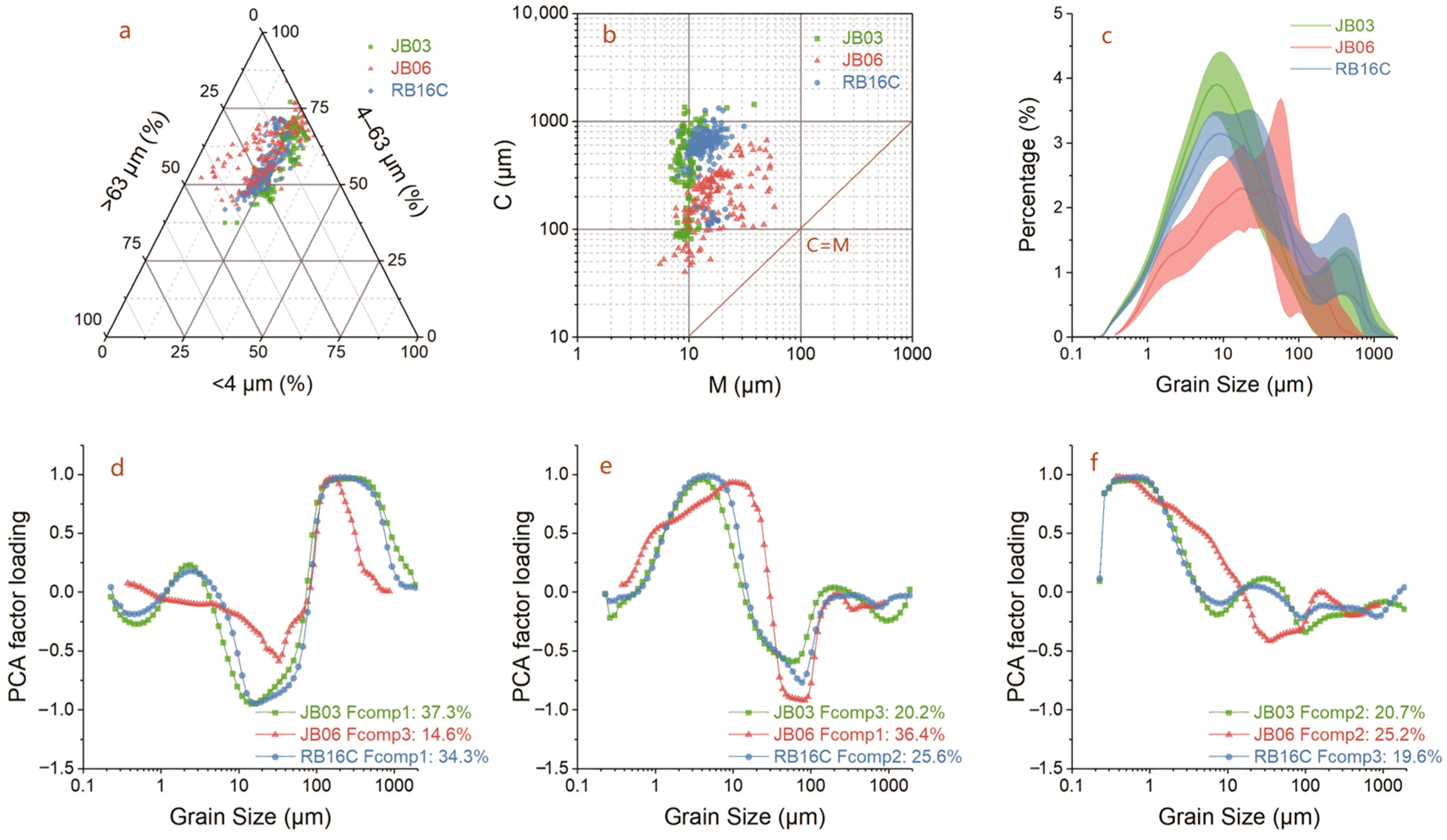
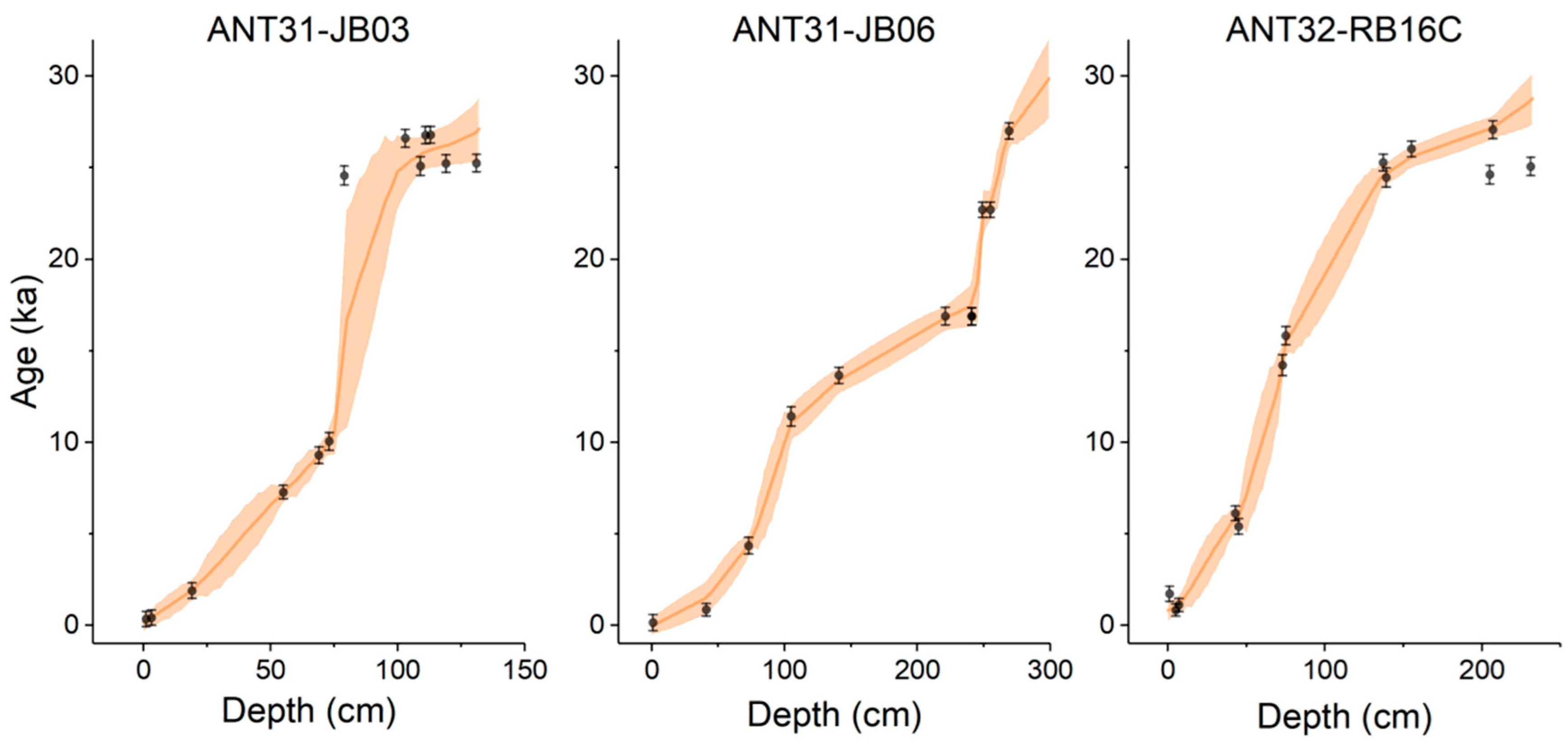
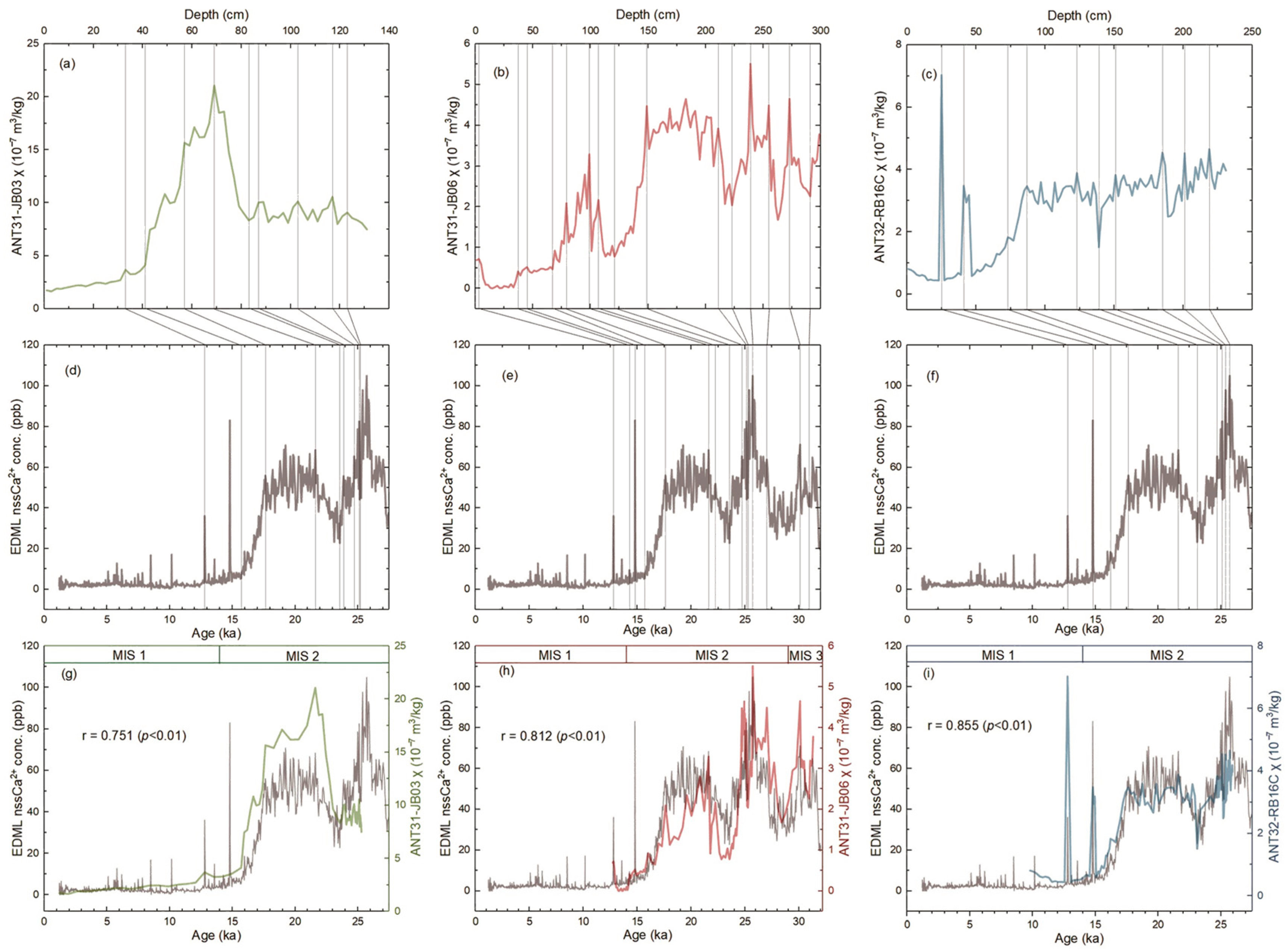
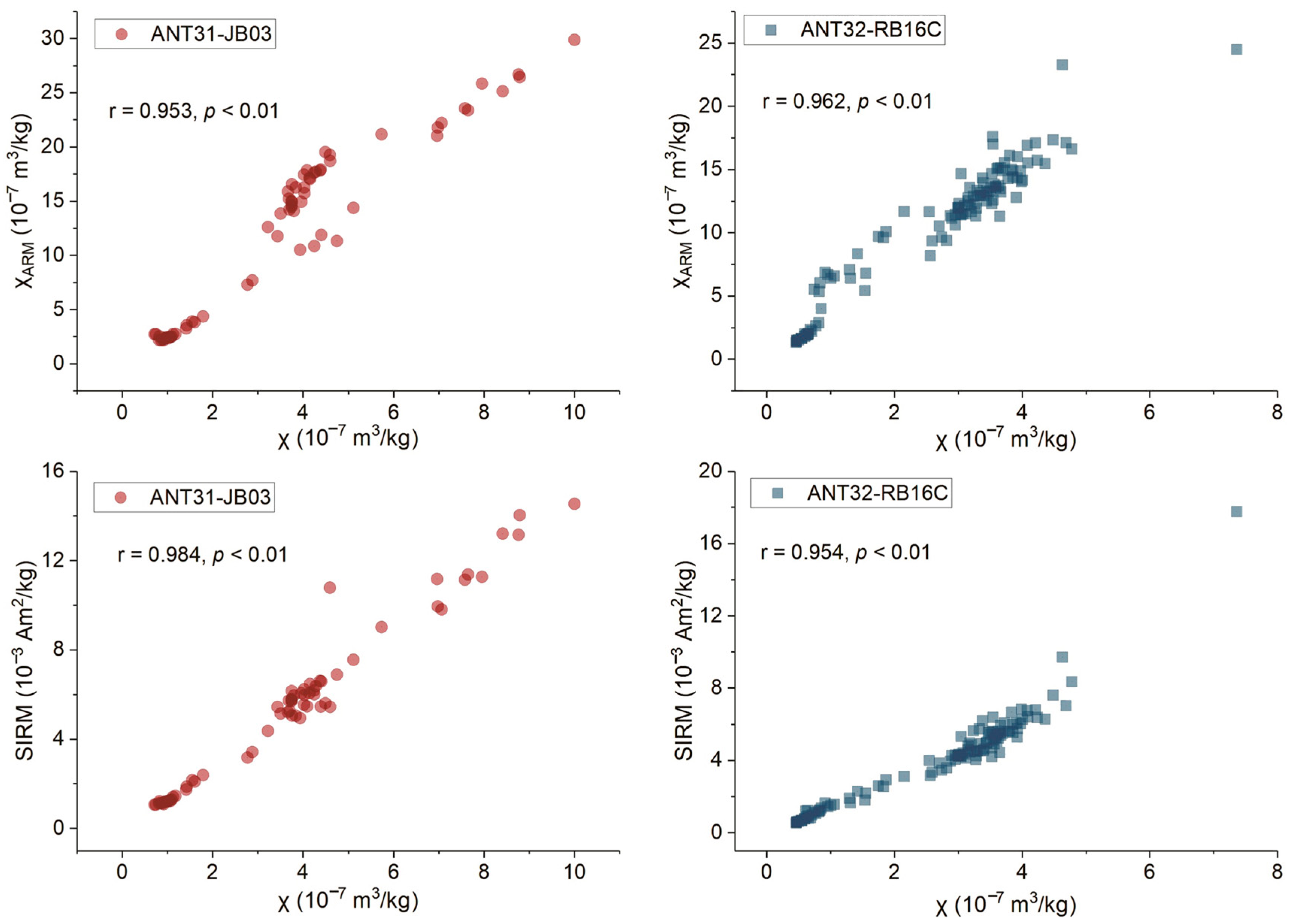
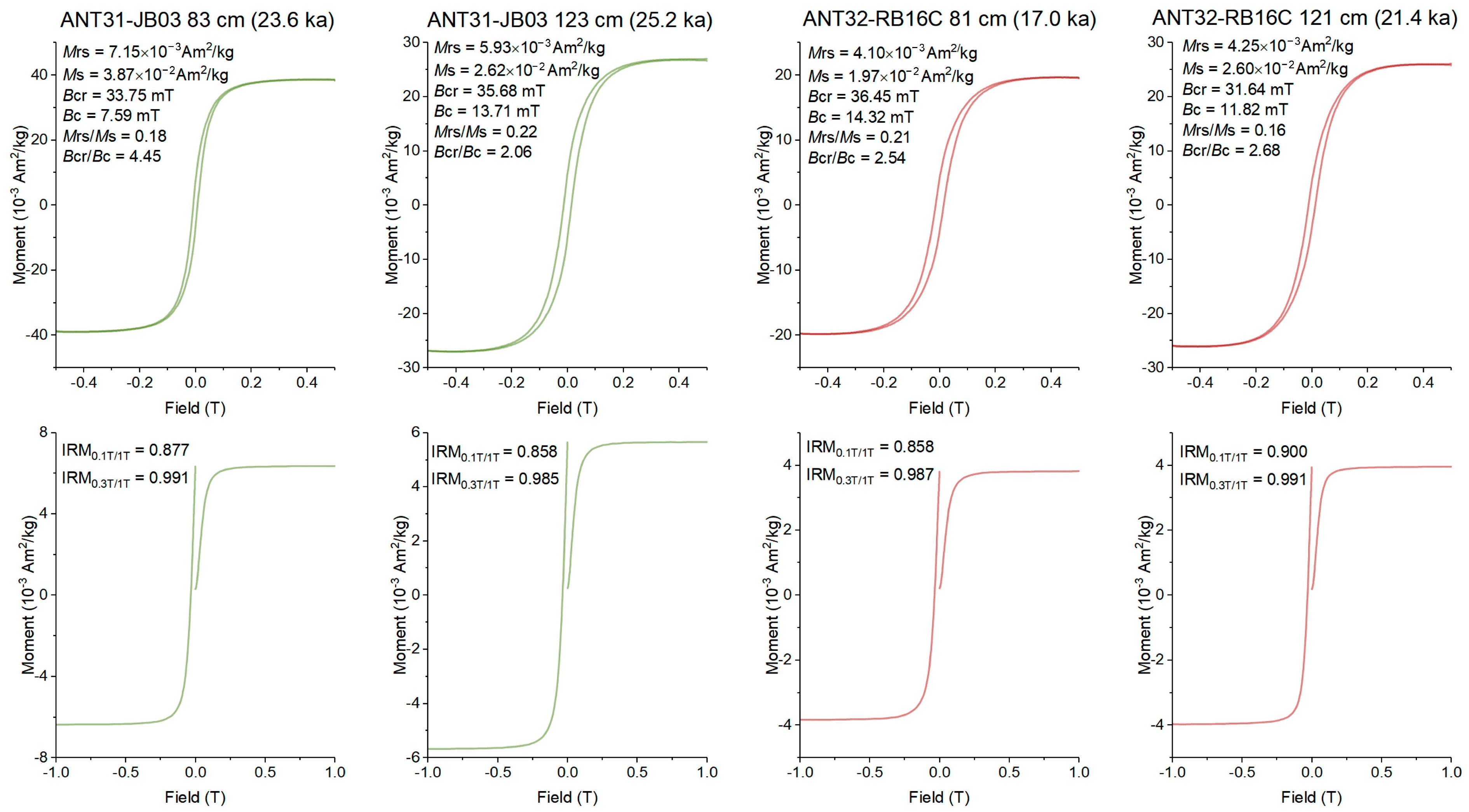
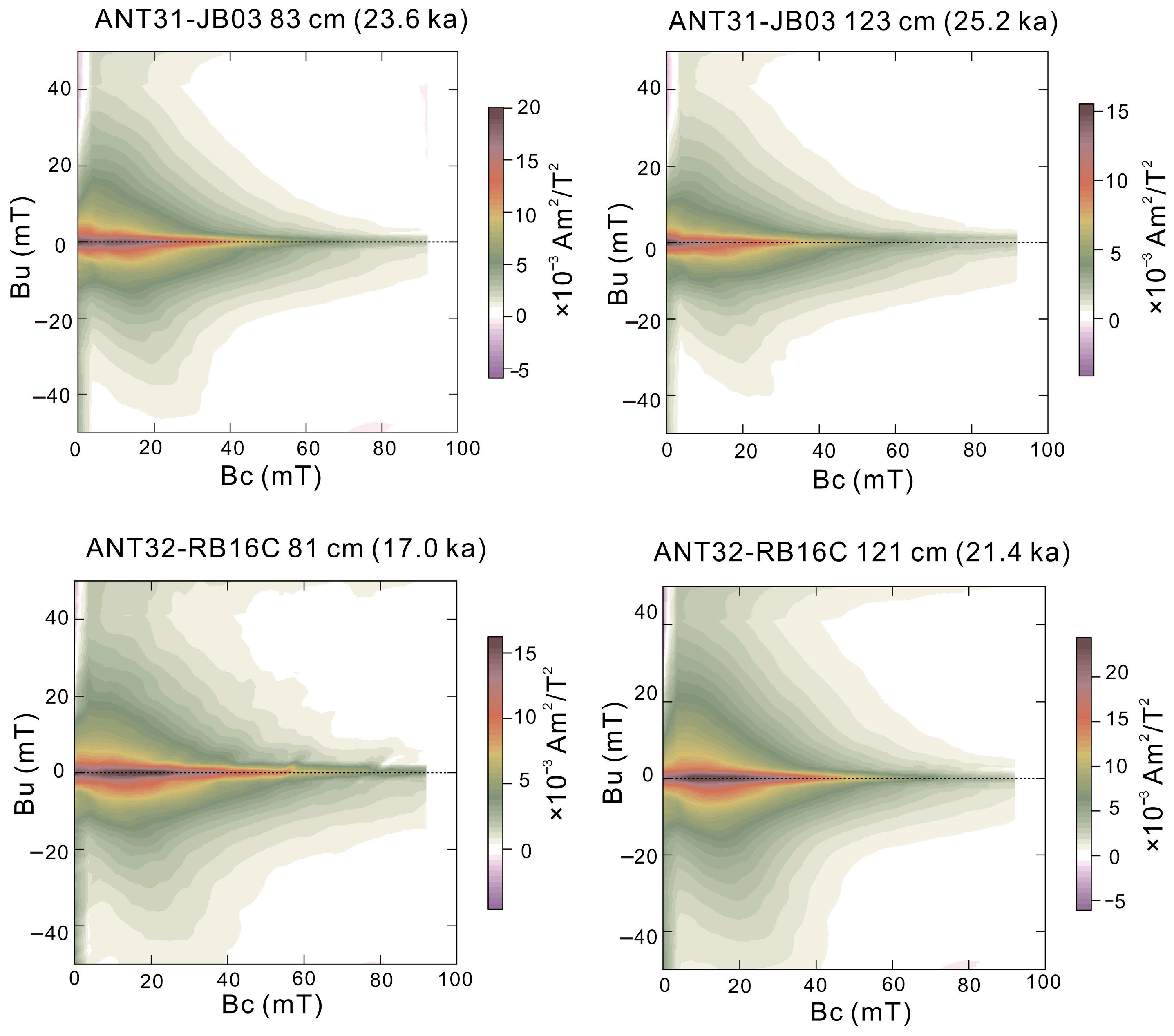

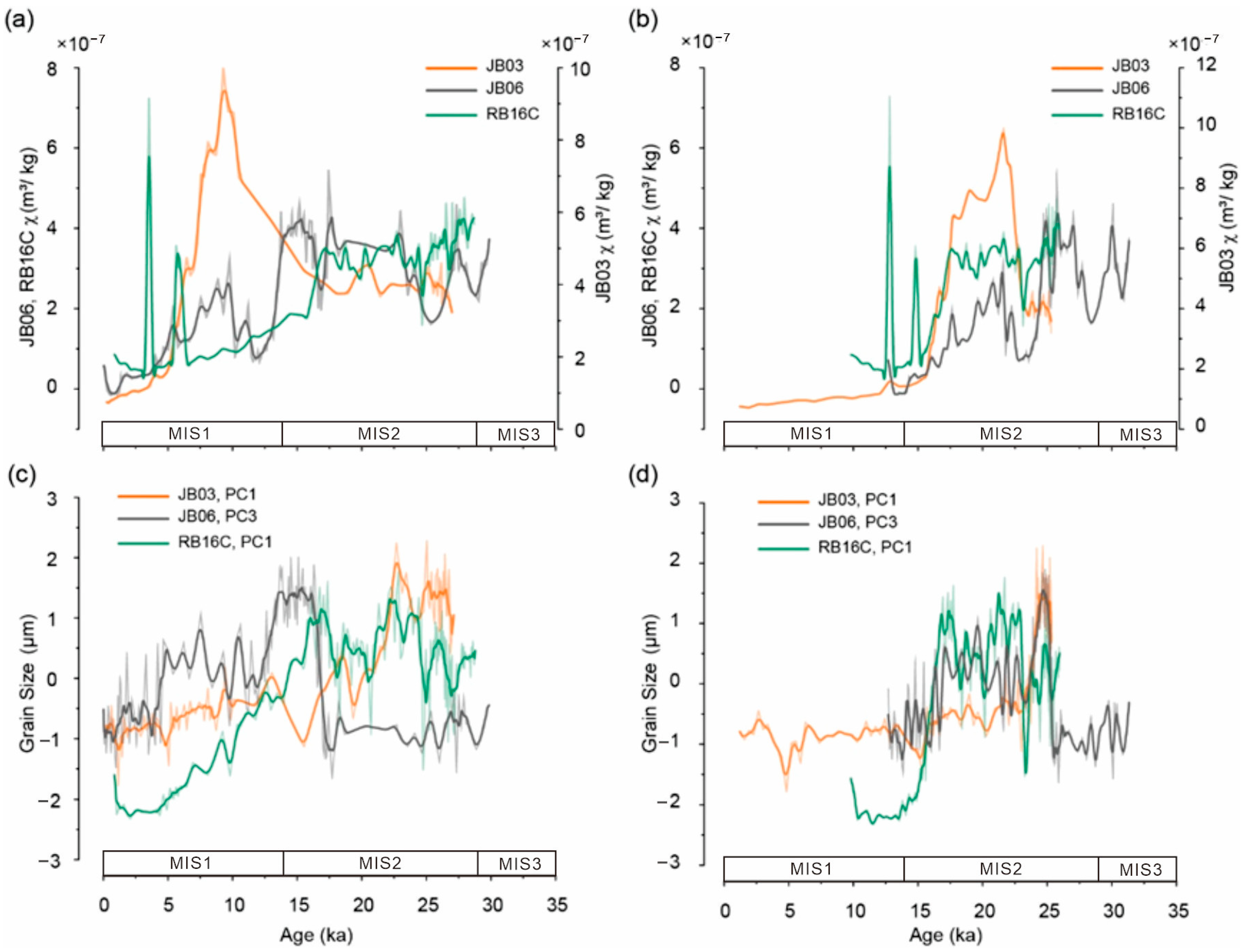

| Station | Latitude | Longitude | Water Depths (m) | Length (cm) |
|---|---|---|---|---|
| ANT31-JB03 | 75°49′00″ S | 170°41′14″ E | 614.0 | 132 |
| ANT31-JB06 | 74°28′22″ S | 173°54′24″ E | 567.5 | 299 |
| ANT32-RB16C | 74°31′06″ S | 175°07′15″ E | 471.0 | 232 |
| Initial Eigenvalues/Extraction | ||||
|---|---|---|---|---|
| Component | Total | % of Variance | Cumulative % | |
| ANT31-JB03 | 1 | 24.637 | 37.329 | 37.329 |
| 2 | 13.634 | 20.658 | 57.987 | |
| 3 | 13.323 | 20.186 | 78.173 | |
| 4 | 6.733 | 10.201 | 88.374 | |
| ANT31-JB06 | 1 | 30.543 | 36.361 | 36.361 |
| 2 | 21.169 | 25.201 | 61.562 | |
| 3 | 12.291 | 14.632 | 76.194 | |
| 4 | 6.582 | 7.836 | 84.029 | |
| ANT32-RB16C | 1 | 22.609 | 34.256 | 34.256 |
| 2 | 16.905 | 25.613 | 59.869 | |
| 3 | 12.966 | 19.646 | 79.515 | |
| 4 | 5.539 | 8.392 | 87.908 | |
| Core | Depth (cm) | Source | Conventional Age ± 1σ (a BP) | Calendar Age ± 2σ (cal a BP) |
|---|---|---|---|---|
| ANT31-JB03 | 0–2 | O | 4060 ± 30 | 347 ± 413 |
| 2–4 | O | 4140 ± 30 | 427 ± 421 | |
| 18–20 | O | 6140 ± 30 | 1898 ± 425 | |
| 54–56 | O | 10,690 ± 40 | 7280 ± 368 | |
| 68–70 | O | 12,530 ± 40 | 9299 ± 467 | |
| 72–74 | O | 13,130 ± 50 | 10,059 ± 488 | |
| 78–80 | O | 25,000 ± 100 | 24,583 ± 517 | |
| 102–104 | O | 26,940 ± 120 | 26,615 ± 491 | |
| 108–110 | O | 25,440 ± 110 | 25,103 ± 509 | |
| 110–112 | O | 27,120 ± 140 | 26,787 ± 474 | |
| 112–114 | O | 27,130 ± 130 | 26,799 ± 462 | |
| 118–120 | O | 25,560 ± 110 | 25,239 ± 480 | |
| 130–132 | O | 25,580 ± 110 | 25,260 ± 475 | |
| ANT31-JB06 | 0–2 | O | 3870 ± 15 | 157 ± 439 |
| 40–42 | O | 5175 ± 15 | 858 ± 337 | |
| 72–74 | O | 8110 ± 20 | 4354 ± 454 | |
| 104–106 | O | 14,100 ± 30 | 11,427 ± 526 | |
| 140–142 | O | 16,010 ± 40 | 13,666 ± 439 | |
| 220–222 | O | 18,360 ± 50 | 16,898 ± 480 | |
| 240–242 | O | 18,355 ± 45 | 16,892 ± 477 | |
| 240–242 | B | 15,310 ± 35 | 16,892 ± 471 | |
| 248–250 | B | 20,300 ± 60 | 22,721 ± 414 | |
| 254–256 | B | 20,300 ± 60 | 22,721 ± 414 | |
| 268–270 | B | 24,290 ± 90 | 27,019 ± 449 | |
| ANT32-RB16C | 0–2 | O | 6000 ± 30 | 1730 ± 414 |
| 4–6 | O | 5150 ± 30 | 835 ± 337 | |
| 6–8 | O | 5440 ± 30 | 1118 ± 369 | |
| 42–44 | O | 9620 ± 40 | 6122 ± 399 | |
| 44–46 | O | 8960 ± 30 | 5406 ± 427 | |
| 72–74 | O | 16,400 ± 50 | 14,222 ± 573 | |
| 74–76 | O | 17,520 ± 50 | 15,831 ± 498 | |
| 136–138 | O | 25,610 ± 100 | 25,292 ± 457 | |
| 138–140 | O | 24,910 ± 90 | 24,475 ± 513 | |
| 154–156 | O | 26,390 ± 110 | 26,037 ± 434 | |
| 204–206 | O | 25,040 ± 100 | 24,631 ± 513 | |
| 206–208 | O | 27,410 ± 130 | 27,086 ± 492 | |
| 230–232 | O | 25,420 ± 100 | 25,080 ± 504 |
| JB03 Depth (cm) | Age (ka) | JB06 Depth (cm) | Age (ka) | RB16C Depth (cm) | Age (ka) |
|---|---|---|---|---|---|
| 33 | 12.80 | 3 | 12.80 | 25 | 12.80 |
| 41 | 15.70 | 37 | 14.29 | 41 | 14.80 |
| 57 | 17.63 | 45 | 14.80 | 73 | 16.21 |
| 69 | 21.62 | 67 | 15.70 | 87 | 17.63 |
| 83 | 23.57 | 79 | 17.63 | 123 | 21.62 |
| 89 | 23.87 | 99 | 21.62 | 139 | 23.12 |
| 103 | 24.71 | 107 | 22.25 | 151 | 24.71 |
| 117 | 25.12 | 121 | 23.57 | 185 | 25.12 |
| 123 | 25.20 | 149 | 24.71 | 201 | 25.40 |
| 211 | 25.12 | 219 | 25.72 | ||
| 223 | 25.27 | ||||
| 239 | 25.72 | ||||
| 255 | 27.02 | ||||
| 273 | 30.10 | ||||
| 291 | 30.95 |
| ANT31-JB03 | ANT31-JB06 | ANT32-RB16C | |||
|---|---|---|---|---|---|
| χ | χ | χ | |||
| EDML nssCa2+ | 0.737 | EDML nssCa2+ | 0.812 | EDML nssCa2+ | 0.855 |
| F1 (134.0–466.5 μm) | 0.619 | F3 (121.8–213.2 μm) | 0.436 | F1 (116.6–535.9 μm) | 0.644 |
| F3 (3.2–4.8 μm) | 0.453 | F1 (5.1–17.2 μm) | −0.669 | F2 (2.1–8.4 μm) | 0.525 |
Disclaimer/Publisher’s Note: The statements, opinions and data contained in all publications are solely those of the individual author(s) and contributor(s) and not of MDPI and/or the editor(s). MDPI and/or the editor(s) disclaim responsibility for any injury to people or property resulting from any ideas, methods, instructions or products referred to in the content. |
© 2024 by the authors. Licensee MDPI, Basel, Switzerland. This article is an open access article distributed under the terms and conditions of the Creative Commons Attribution (CC BY) license (https://creativecommons.org/licenses/by/4.0/).
Share and Cite
Liu, G.; Shen, Z.; Han, X.; Wang, H.; Chen, W.; Zhang, Y.; Ma, P.; Li, Y.; Cai, Y.; Xue, P.; et al. Chronology and Sedimentary Processes in the Western Ross Sea, Antarctica since the Last Glacial Period. J. Mar. Sci. Eng. 2024, 12, 254. https://doi.org/10.3390/jmse12020254
Liu G, Shen Z, Han X, Wang H, Chen W, Zhang Y, Ma P, Li Y, Cai Y, Xue P, et al. Chronology and Sedimentary Processes in the Western Ross Sea, Antarctica since the Last Glacial Period. Journal of Marine Science and Engineering. 2024; 12(2):254. https://doi.org/10.3390/jmse12020254
Chicago/Turabian StyleLiu, Geng, Zhongshan Shen, Xibin Han, Haifeng Wang, Weiwei Chen, Yi Zhang, Pengyun Ma, Yibing Li, Yun Cai, Pengfei Xue, and et al. 2024. "Chronology and Sedimentary Processes in the Western Ross Sea, Antarctica since the Last Glacial Period" Journal of Marine Science and Engineering 12, no. 2: 254. https://doi.org/10.3390/jmse12020254






